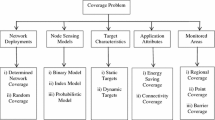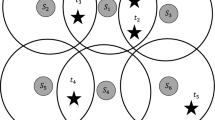Abstract
In wireless sensor networks, when each target is covered by multiple sensors, sensors can take turns to monitor the targets in order to extend the lifetime of the network. In this paper, we address how to improve network lifetime through optimal scheduling of sensor nodes. We present two algorithms to achieve the maximum lifetime while maintaining the required coverage: a linear programming-based exponential-time exact solution, and an approximation algorithm. Numerical simulation results from the approximation algorithm are compared to the exact solution and show a high degree of accuracy and efficiency.
Similar content being viewed by others
References
Cardei M., MacCallum D., Cheng M.X., Min M., Jia X., Li D., Du D.Z.: Wireless sensor networks with energy efficient organization. J. Interconnect. Netw. 3(3&4), 213–229 (2002)
Cardei, M., Thai, M., Li, Y., Wu, W.: Energy-efficient target coverage in wireless sensor networks. In: IEEE INFOCOM 2005, pp. 1976–1984 (2005)
Cheng, M., Ruan, L., Wu, W.: Achieving minimum coverage breach under bandwidth constraints in wireless sensor networks. In: IEEE Infocom 2005, pp. 2638–2645 (2005)
Cheng, M., Ruan, L., Wu, W.: Coverage breach problems in bandwidth constrained sensor networks. ACM Transactions on Sensor Networks (Vol.3, No. 2, Artical 12, June 2007)
Choi, W., Das, S.: Trade-off between coverage and data reporting latency for energy-conserving data gathering in wireless sensor networks. In: Mobile Ad-hoc and Sensor Systems, 2004 IEEE International Conference on, pp. 503–512 (2004)
Garey, M., Johnson, D.: Computers and intractability, a guide to the theory of NP-Completeness. FREEMAN (1974)
Gupta H., Zhou Z., Das S.R., Gu Q.: Connected sensor cover: self-organization of sensor networks for efficient query execution. IEEE/ACM Trans. Netw. 14(1), 55–67 (2006)
Li, X.Y., Wan, P.J., Frieder, O.: Coverage in wireless ad-hoc sensor networks. In: IEEE International Conference on Communications (ICC 2002), New York, pp. 3174–3178 (April 2002)
Li X.Y., Wan P.J., Frieder O.: Coverage in wireless ad hoc sensor networks. IEEE Trans. Comput. 52(6), 753–763 (2003)
Liu H., Jia X., Wan P.J., Yi C.W., Makki S.K., Pissinou N.: Maximizing lifetime of sensor surveillance systems. IEEE/ACM Trans. Netw. 15(2), 334–345 (2007)
Megerian S., Koushanfar F., Potkonjak M., Srivastava M.: Worst and best-case coverage in sensor networks. Mobile Comput. IEEE Trans. 4(1), 84–92 (2005)
Megerian S., Koushanfar F., Qu G., Veltri G., Potkonjak M.: Exposure in wireless sensor networks: theory and practical solutions. J. Wireless Netw. 8(5), 443–454 (2002)
Meguerdichian, S., Koushanfar, F., Potkonjak, M., Srivastava, M.B.: Coverage problems in wireless ad-hoc sensor networks. In: INFOCOM, vol. 3, pp. 1380–1387 (2001)
Rakhmatov D., Vrudhula S.: Energy management for battery-powered embedded systems. Trans. Embedded Comput. Syst. 2(3), 277–324 (2003)
Resende, M.G.C., Paradalos, P.M. (eds.): Handbook of optimization in telecommunications. Spinger Science + Business Media, New York (February 2006)
Sheu, J.P., Lin, H.F.: Probabilistic coverage preserving protocol with energy efficiency in wireless sensor networks. In: IEEE WCNC 2007, pp. 2631–2636 (2007)
Slijepcevic, S., Potkonjak, M.: Power efficient organization of wireless sensor networks. In: IEEE International Conference on Communications, Helsinki, Finland, vol. 2, pp. 472–476 (2001)
Sorokin A., Boyko N., Boginski V., Uryasev S., Pardalos P.M.: Mathematical programming techniques for sensor networks. Algorithms 2(1), 565–581 (2009)
Tian, D., Georganas, N.: A coverage-preserving node scheduling scheme for large wireless sensor networks. In: Proceedings of ACM Workshop on Wireless Sensor Networks and Applications, Atlanta, October 2002, pp. 32–41 (2002)
Wu W., Gao X., Pardalos P.M., Du D.Z.: Wireless networking, dominating and packing. Optim. Lett. 4(3), 347–358 (2010)
Yan, T., He, T., Stankovic, J.A.: Differentiated surveillance for sensor networks. In: Proceedings of the first international conference on Embedded networked sensor systems, pp. 51–62 (2003)
Yang, B., Yu, H., Li, H., Hou, H.: A coverage-preserving density control algorithm based-on cooperation in wireless sensor networks. In: WiCOM 2006, pp. 1–4 (2006)
Ye, F., Zhong, G., Cheng, J., Lu, S., Zhang, L.: Peas: A robust energy conserving protocol for long-lived sensor networks. In: Proceedings of the 23rd International Conference on Distributed Computing Systems (ICDCS03), pp. 28–37 (May 2003)
Yen, Y.S., Hong, S., Chang, R.S., Chao, H.C.: An energy efficient and coverage guaranteed wireless sensor network. In: IEEE WCNC 2007, pp. 2923–2928 (2007)
Zhang H., Hou J.C.: Maintaining sensing coverage and connectivity in large sensor networks. Wireless Ad Hoc Sensor Netw.: Int. J. 1(1–2), 89–123 (2005)
Author information
Authors and Affiliations
Corresponding author
Additional information
Maggie X. Cheng and Xuan Gong are supported in part by National Science Foundation under grant CNS-0841388.
Rights and permissions
About this article
Cite this article
Cheng, M.X., Gong, X. Maximum lifetime coverage preserving scheduling algorithms in sensor networks. J Glob Optim 51, 447–462 (2011). https://doi.org/10.1007/s10898-010-9636-3
Received:
Accepted:
Published:
Issue Date:
DOI: https://doi.org/10.1007/s10898-010-9636-3




